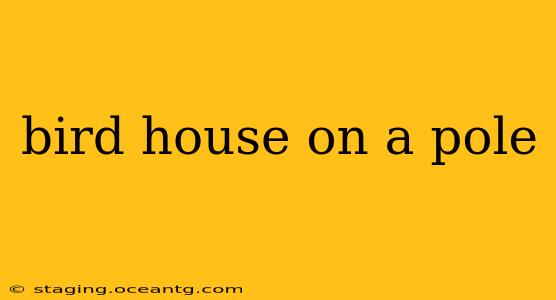Attracting birds to your backyard is a rewarding experience, and a birdhouse on a pole offers a fantastic way to provide safe and comfortable housing for your feathered friends. This comprehensive guide covers everything from choosing the right location and materials to construction and maintenance, helping you build the ideal birdhouse on a pole.
What Kind of Birds Will Use a Pole-Mounted Birdhouse?
Many bird species will happily utilize a pole-mounted birdhouse, but the type of birdhouse you build will dictate which species are most likely to inhabit it. Smaller species such as chickadees, titmice, and wrens prefer smaller houses, while larger birds like bluebirds or woodpeckers require larger cavities. Consider the local bird species in your area when deciding on the size and design of your birdhouse.
What Height Should a Birdhouse Pole Be?
The ideal height for a birdhouse pole depends largely on the type of bird you're hoping to attract and the surrounding environment. Generally, a height of 4-6 feet is a good starting point for most species. However, placing the birdhouse higher (up to 10 feet) can provide better protection from predators like cats. Consider the presence of trees or shrubs that could offer cover for predators when deciding on the optimal height.
How to Build a Birdhouse on a Pole: A Step-by-Step Guide
Building a birdhouse on a pole is a manageable DIY project that requires basic carpentry skills. Here's a simplified outline:
1. Gather Your Materials: You'll need untreated wood (cedar or redwood are excellent choices), screws, a pole (metal or treated wood), a metal post mount, and appropriate paint or stain (if desired).
2. Construct the Birdhouse: Follow plans specific to the bird species you wish to attract. Accurate dimensions are crucial for the successful use of the birdhouse. Many free plans are available online. Ensure the entrance hole is the correct size for your target species.
3. Attach the Birdhouse to the Pole: Securely fasten the birdhouse to the pole using the metal post mount. The mount should be strong enough to withstand wind and potential predator attacks.
4. Install the Pole: Choose a location away from direct sunlight and prevailing winds. Plant the pole firmly into the ground, ensuring stability. You may need to use concrete to secure the pole.
5. Protect the Birdhouse: Apply a weather-resistant sealant or paint to protect the wood from the elements.
What Materials Should I Use for a Birdhouse Pole?
Metal poles are generally preferred for their durability and resistance to rot, making them ideal in a variety of climates. However, treated wooden poles are also an option, but require regular maintenance to prevent rot and decay. Choosing the right pole material depends on your budget and climate. Remember to avoid using chemically-treated wood directly in the birdhouse itself.
How Do I Protect a Birdhouse on a Pole from Predators?
Protecting the birdhouse from predators is crucial for the success of your project. Consider these measures:
- Height: As previously mentioned, a higher pole makes it more difficult for cats and other predators to reach the birdhouse.
- Pole Baffle: Attach a metal cone or baffle around the pole below the birdhouse to prevent predators from climbing up.
- Location: Carefully choose the location; avoid placing it near trees or shrubs that predators could use for cover.
How Often Should I Clean a Birdhouse on a Pole?
Cleaning a birdhouse is important for maintaining its hygiene and preventing the spread of disease. Clean the birdhouse after the nesting season ends in the fall. Remove old nests and debris gently. Scrub the interior with a mild soap and water solution, then rinse thoroughly and allow it to dry completely before reinstalling it.
By following these steps and considerations, you can successfully attract birds to your backyard with a well-built and strategically placed birdhouse on a pole. Enjoy the beautiful sights and sounds of nature flourishing in your own backyard!
